Die charmante Küstenstadt Marseille wurde bereits in der Antike gegründet. Der einst wichtige Handelshafen wird heute von Touristen bevölkert, die sich von dem sehenswerten Mix aus Alt und Neu, Highlife und Entspannung, Stadt und Meer verzaubern lassen.
Das malerische Marseille am Mittelmeer wurde der Legende nach von Griechen und Kelten gegründet und ist die älteste Stadt Frankreichs. Bereits zu Zeiten der alten Griechen und Römer war die Stadt an der Südküste Frankreichs ein wichtiger Handelshafen.
Heute beeindruckt Marseille durch seine historisch wertvollen Baudenkmäler und eignet sich ideal als Ausgangspunkt für Ausflüge in die Provence und an die französische Riviera.
Die Stadt ist verkehrsmäßig sehr gut vernetzt. Die Anreise nach Marseille kann ganz individuell per Schiff, Bahn, Auto oder Flugzeug erfolgen:
- Der TGV hält direkt am Hauptbahnhof Saint Charles im Zentrum der Stadt. Die Anreise aus dem 750 Kilometer entfernten Paris mit dem Zug dauert rund drei Stunden.
- Mit dem Flugzeug landet ihr am Flughafen Marseille Provence in Marignane.
- Mit dem Auto dauert die Fahrt nach Marseille vom Flughafen eine knappe halbe Stunde. Haltet euch am besten an den Schildern Richtung Vieux Port, so kommt ihr direkt ins Zentrum.
- Schiffe legen im alten oder neuen Hafen von Marseille an. Der Vieux Port (alter Hafen) grenzt direkt an die charmante Altstadt und liegt in unmittelbarer Nähe einiger unserer Top 10 Sehenswürdigkeiten von Marseille.
Inhaltsverzeichnis
Alter Hafen (Vieux Port)

Der Alte Hafen von Marseille ist einer der ältesten Hafenanlagen von Europa. Archäologische Funde datieren seinen Ursprung auf das 7. Jahrhundert vor Christus zurück. Bereits in der Antike liefen hier täglich Seehandelsschiffe und riesige Galeeren ein und aus. Der natürliche Hafen von Marseille war außerdem ein begehrter geschützter Platz an der felsigen Küste Südfrankreichs.
Heute treffen sich am Vieux Port von Marseille immer noch schnittige Yachten und Segelboote. Diese bringen jedoch kaum mehr Waren, sondern hauptsächlich Touristen ins zauberhafte Marseille, denn für große Frachter hat der Hafen zu wenig Tiefgang.
Urlauber nutzen den Alten Hafen als idealen Ausgangspunkt für Sightseeing in Marseille. Direkt am Hafen liegen die beiden Festungen Saint-Jean und Saint-Nicolas, sowie das Château d’If auf einer der Frioul-Inseln. Ein Spaziergang entlang der Hafenpromenade führt zum alten Rathaus, der kleinen Kirche Saint-Ferreol, Märkten, Museen und dem Théâtre de la Crièe.
Am Vieux Port spielt sich auch das Nachtleben von Marseille ab. In den milden Nächten Südfrankreichs schallt Musik aller Jahrzehnte und Stilrichtungen aus den Bars und an der beleuchteten Hafenpromenade kommt unweigerlich Urlaubsfeeling auf.
Artikel: Alter Hafen (Vieux Port) von Marseille
Fotogalerie: Alter Hafen (Vieux Port) von Marseille
Festung Saint Jean und MuCEM
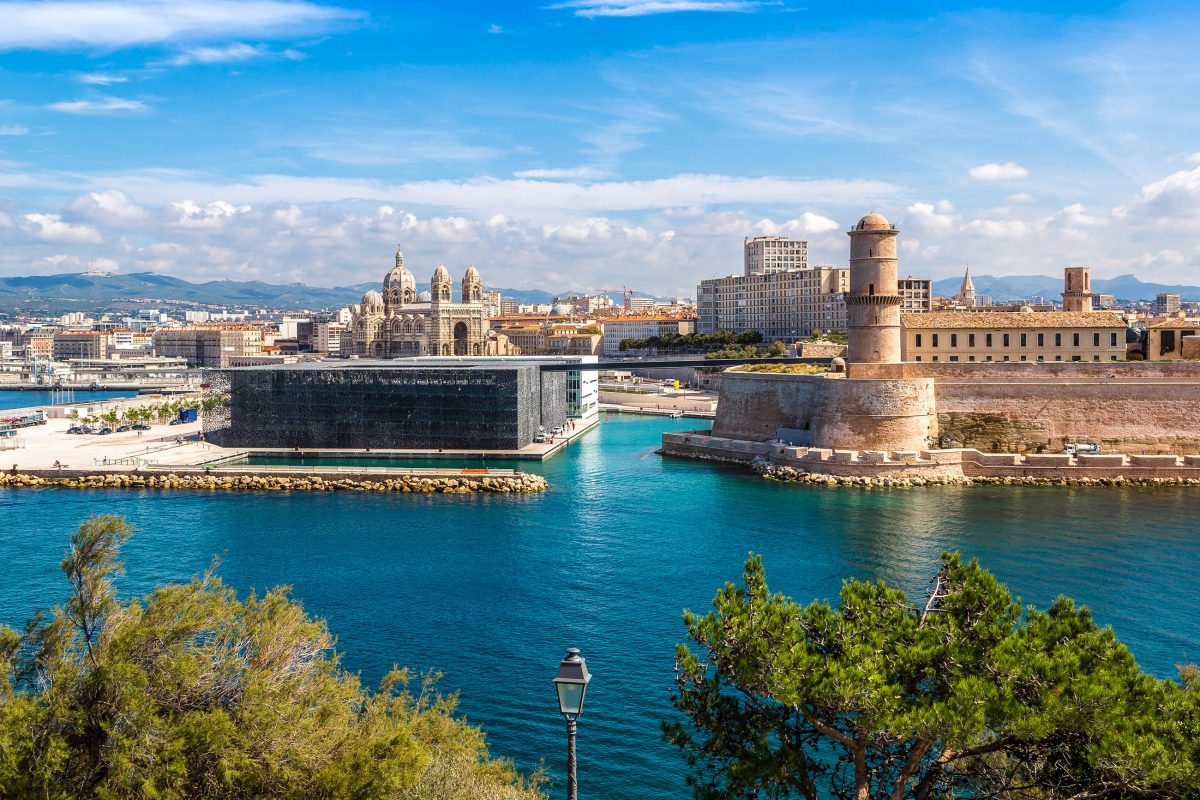
Die Festung Saint-Jean thront am Eingang zum alten Hafen von Marseille. Sie wurde im 17. Jahrhundert im Auftrag des Sonnenkönigs erbaut. Offiziell sollte es den wichtigen Handelshafen von Museum befestigen, inoffiziell die selbstbewussten Einwohner von Marseille unter Kontrolle halten.
Heute ist die Festung Teil des Museums für europäische und mediterrane Zivilisation (MuCEM). Gemeinsam mit dem benachbarten modernen „Museum aus Stein, Wasser und Wind“ ist es das einzige Museum weltweit, welches sich ausschließlich mit den Kulturen des Mittelmeerraums beschäftigt.
Zu sehen gibt es rund eine Million Kunstgegenstände, zahlreiche Pflanzen im „Jardin des Migrations“ und eine wunderbare Aussicht vom Restaurant und Café des Museums.
Artikel: Festung Saint Jean und MuCEM in Marseille
Fotogalerie: Festung Saint Jean in Marseille
Fotogalerie: MuCEM in Marseille
Château d’If
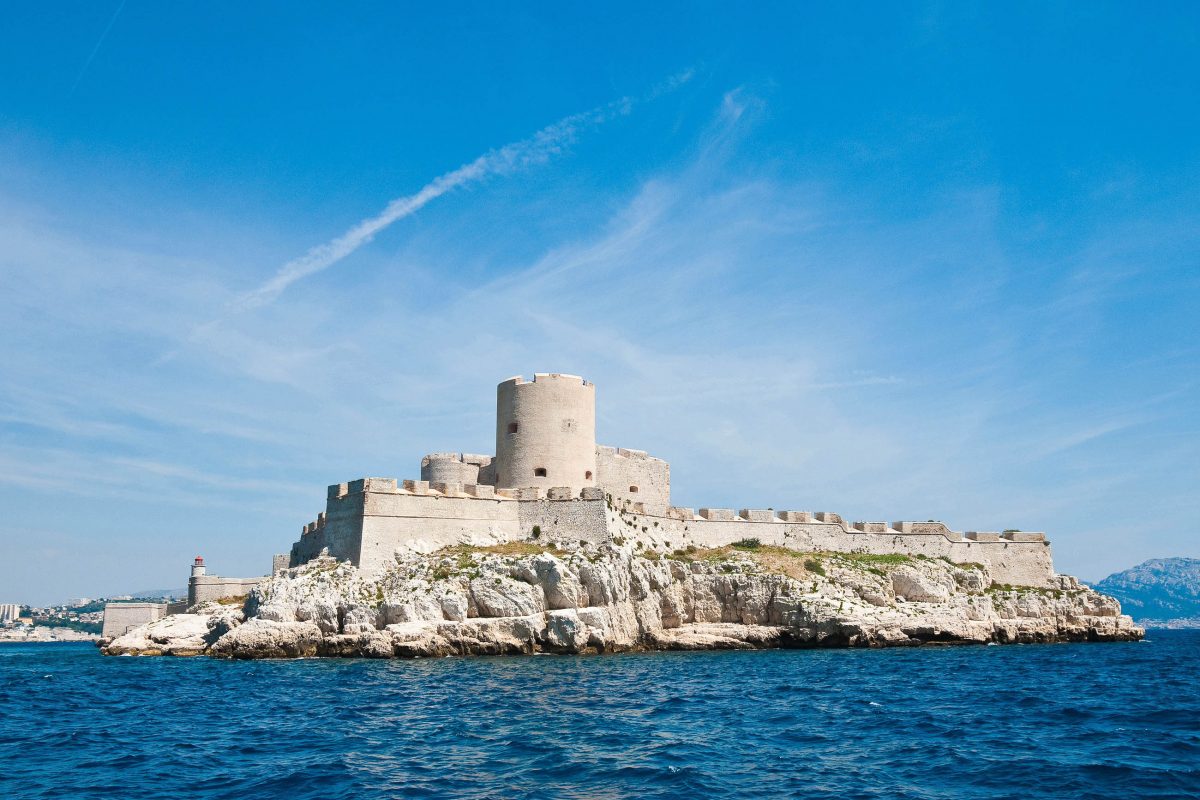
Eine weitere sehenswerte Festung an der Küste von Marseille ist das berühmt-berüchtigte Château d’If auf einer der vorgelagerten Frioul-Inseln. Das ehemalige Staatsgefängnis wurde durch den Roman „Der Graf von Monte Cristo“ weltberühmt, steht heute unter Denkmalschutz und kann besichtigt werden.
Die Besichtigung der Insel ist kostenlos, wer auch die Festung von innen sehen möchte, muss Eintritt zahlen. Im Inneren von Château d’If erzählt ein kleines Museum die Geschichte der Festung und das tragische Ende des ersten Nashorns Europas.
Artikel: Château d’If in Marseille
Fotogalerie: Château d’If in Marseille
Basilika Notre Dame de la Garde
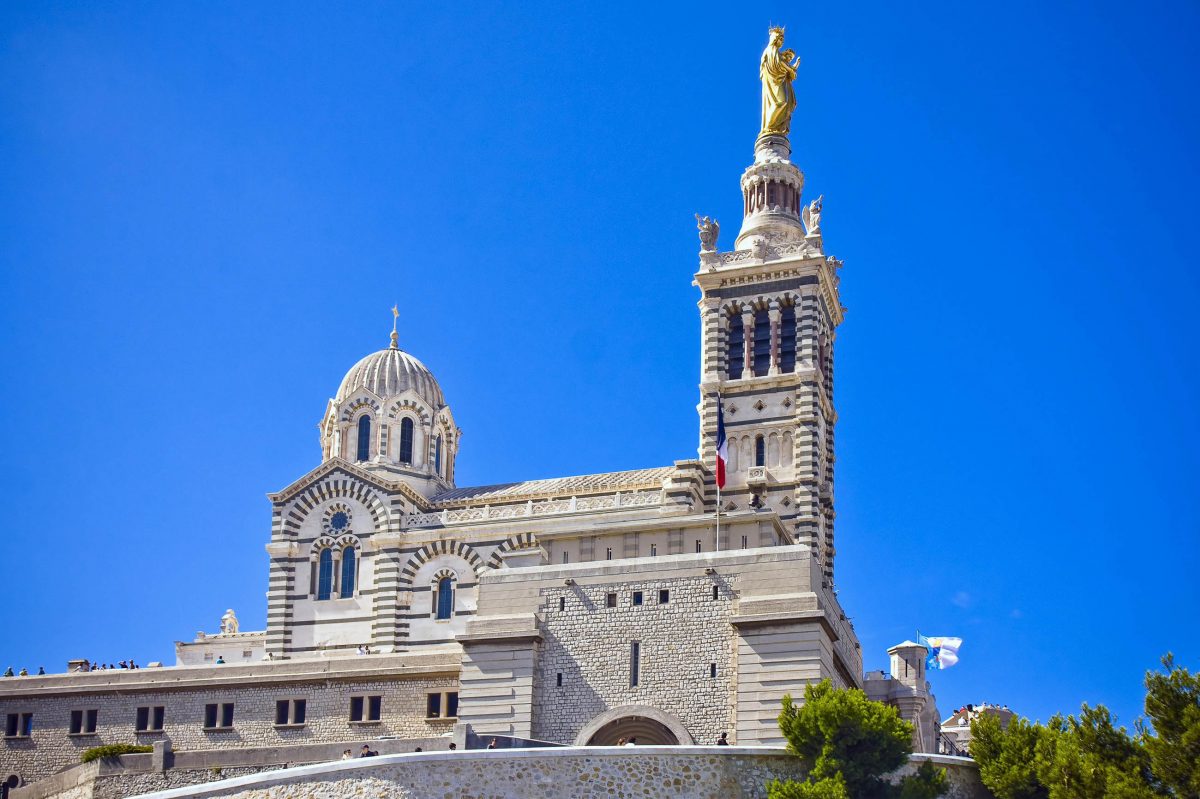
Vom Vieux Port führt eine lange Steintreppe auf den Hügel mit der weithin sichtbaren Basilika Notre Dame de la Garde. Das Wahrzeichen von Marseille wird jedes Jahr von rund 2 Millionen Menschen besucht. Auch hier stand einst eine Festung, heute ist die Basilika Notre Dame de la Garde ein wichtiger Wallfahrtsort.
Ihre liebevoll dekorierte Fassade und der opulent geschmückte Innenraum zeugen von der typischen Architektur zu Napoleons Zeiten. Sehenswert ist auch das Museum für sakrale Kunst und der sensationelle Ausblick von der Terrasse auf dem „La Garde“.
Artikel: Basilika Notre Dame de la Garde in Marseille
Fotogalerie: Basilika Notre Dame de la Garde in Marseille
Cathédrale de la Major
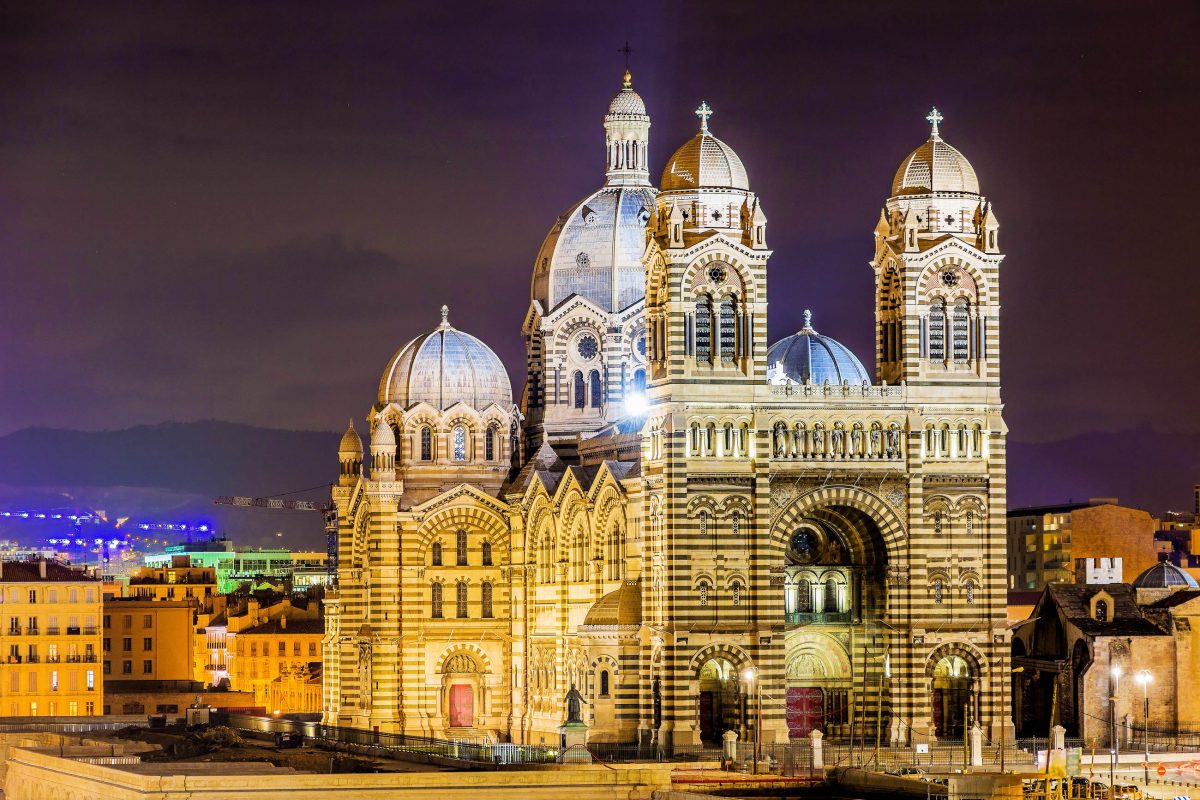
Auch die majestätische Kathedrale von Marseille mit dem Sitz des Erzbischofs liegt nur einen Steinwurf vom Alten Hafen entfernt. Sie stammt aus der napoleonischen Ära und ist damit eine der weltweit größten Kathedralen, die nach dem Mittelalter gebaut wurden.
Die Querstreifen und die vielen Kuppeln und Bögen sind typisch für die byzantinische Architektur, die sich auch in ihrem Inneren fortsetzt. Der gewaltige Innenraum unter der ebenso eindrucksvollen Kuppel bietet 3000 Gläubigen Platz. Jedes Jahr am 15. August feiern hier etwa doppelt so viele Menschen das Marienfest mit einer feierlichen Prozession.
Artikel: Cathédrale de la Major in Marseille
Fotogalerie: Cathédrale de la Major in Marseille
Canebière und Palais Longchamp
Shoppingfreunde sollten sie unbedingt gesehen haben: die Canebière ist DIE Einkaufsstraße von Marseille. Die Ähnlichkeit ihres Namens zu Cannabis stammt übrigens nicht von ungefähr, denn hier wurde einst reger Handel mit Hanf betrieben. Sie führt rund 1km vom Hafen in nordöstlicher Richtung bis zur Église des Réformés und wird neben Geschäften aller Art von mehreren Prunkbauten gesäumt.
Eines dieser prächtigen Gebäude ist das Palais Longchamps an ihrem Ende. Das repräsentative Wasserschloss stammt aus dem Jahr 1869 und wurde zur Feier der Fertigstellung des Canal de Marseille errichtet. Damit zählt es zu den wichtigsten Bauten des Zweiten Kaiserreichs in Marseille. Auch der imposante Brunnen symbolisiert die lang ersehnte Ankunft des Wassers.
Der zoologische Garten im Anschluss an das Wasserschloss lädt zum Flanieren ein. In seinem Inneren sind das Museum der Schönen Künste und das Naturhistorische Museum untergebracht – ideale Ziele für einen Familienausflug in Marseille.
Nationalpark Calanques
Der Vieux Port ist auch Ausgangspunkt für Bootstouren in die Calanques, die sonst nur zu Fuß zu erreichen sind. Diese zauberhaften Buchten haben sich zwischen Marseille und Cassis in die steil abfallenden Kalksteinwände der Südküste geschnitten.
Das nach Kiefern und Rosmarin duftende Naturparadies wird von zahlreichen Wander- und Radwegen durchzogen und die blau glitzernden Buchten laden zum Baden, Schwimmen und Tauchen ein. Derart glasklares Wasser findet man in Europa sonst selten!
Tipp: Wenn ihr auch Cassis besucht, solltet ihr dort eine Tour in die Calanques buchen. Cassis ist nicht so touristisch wie Marseille und deshalb sind die Preise etwas günstiger.
Stadtviertel Le Panier
Le Panier, genauer gesagt der Place Lenche, ist die Geburtsstätte von Marseille. Hier gründeten die Griechen und Kelten vor rund 2600 Jahren die Stadt Massilia. Heute fasziniert Le Panier mit seinen verwinkelten Gässchen, bunten Künstlerwerkstätten und winzigen Läden.
Das Altstadtviertel wirkt übrigens wirklich alt. Die wenigsten Bauten sind restauriert, manchmal bröckelt sogar der Putz und die Graffiti an allen Ecken und Enden tragen zum magischen Erscheinungsbild des Panier bei – Authentizität vom Feinsten.
Im Norden von Le Panier liegt das ebenfalls interessante Vieille Charité. Das ehemalige Hospiz aus dem 17. Jahrhundert beherbergt hinter seiner arkadenbewährten Fassade das Archäologie-Museum und ein Museum über afrikanische, amerindische und ozeanische Kunst.
Geheimtipp: Hafen Vallon des Auffes
Vallon des Auffes liegt etwa 3km vom Zentrum entfernt und war früher ein Nachbarort von Marseille. Mittlerweile gehört der zauberhafte Hafen in seiner steilen Felsbucht zum Stadtgebiet. Er gilt mit seinen traditionellen Fischerhütten, bunten Häusern und kleinen Restaurants als Geheimtipp unter den Sehenswürdigkeiten von Marseille.
Vor dem Vallon des Auffes streckt eine 5 Meter hohe Art-Deco-Frauenstatue aus Bronze ihre Hände in den Himmel. Das Denkmal wurde 1927 eingeweiht und erinnert an die „Opfer der Armee des Ostens und der fernen Länder“.
Tipp: Ebenfalls direkt am Wasser liegt mit dem Le Docks Village ein weiterer Geheimtipp von Marseille. Das langgezogene historische Gebäude beherbergt ein Restaurant und ein Einkaufszentrum, ist aber vor allem aufgrund seiner kreativen Shops und seiner künstlerischen Architektur sehenswert.
Stade Velodrome
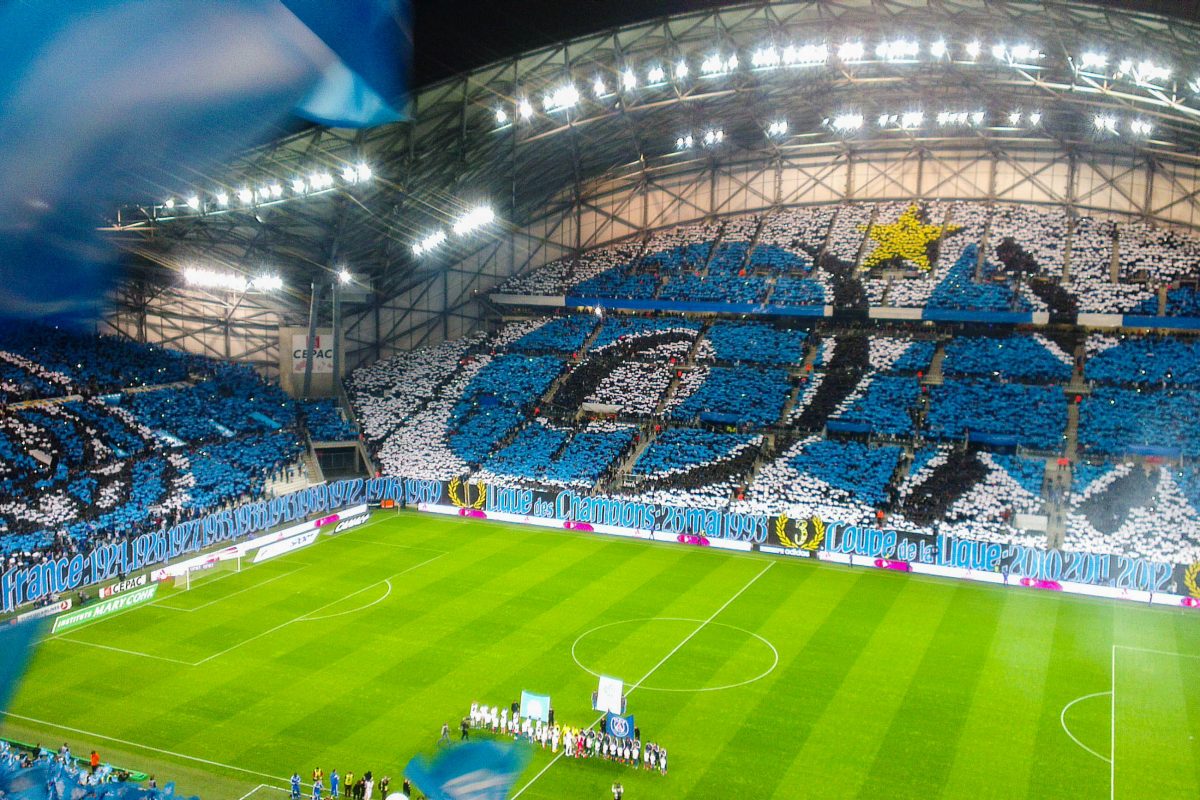
Das Stade Velodrome – Heimat des gefeierten Fußballclubs Olympique Marseille – ist nach dem Stade de France in St. Denis das zweitgrößte Stadion Frankreichs. Es wurde 1937 eröffnet und für die EM 2016 ausgebaut. Die eindrucksvolle Sportstätte zählt zu unseren 10 wichtigsten Fußballstadien Frankreichs und kann auch ohne einem Spiel beizuwohnen besichtigt werden.




